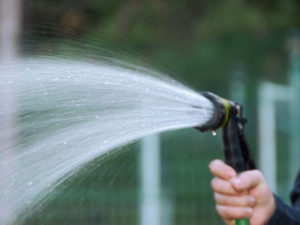Conserve water by following these best practices
The importance of water conservation in the agricultural and horticultural industries is based upon a simple fact-no water, no plants. Increasing demands upon water resources means that there is a lot of competition for a piece of the pie. The more that is done to conserve water, the longer the pie will last for everyone; and the better it is for the environment.

“Water conservation should be a combination of physical enhancements and improved water management practices that optimize existing on-farm resources,” says Marcel Aillery, Agricultural Economist for The United States Department of Agriculture (USDA). “Much can be done to enhance existing systems and maximize efficiency.” An example of enhancing an existing system would be the addition of drop tubes to a pivot irrigation system for more precise applications of water at the crop base. Lining open ditches or enclosing water in pipes are ways of maximizing efficiency because they decrease conveyance losses in the field.
Aillery recommends switching from gravity-flow systems to pressurized systems whenever possible. According to the USDA, gravity flow irrigation can result in up to 50 percent water loss due to evaporation. Plus, it is an uneconomical way to deliver water to the crops. The initial outlay in capital for a pressurized system can be daunting, but costs are offset over time by increased efficiency, greater productivity and reduced labor costs.
Other best management practices for water conservation include:
Irrigation Scheduling ensures that crops are watered at the right time and in the right place, without compromising yields and without gratuitous overwatering. Schedulers must take into account crop type, water supply, priority rights and water prices. The weather is closely monitored for temperature, humidity, rainfall and evapotranspiration (ET) rates. Accessing water requirements for individual crops also plays an important role in irrigation scheduling.
Laser Leveling involves grading the soil to reduce slope and eliminate gradient variation. Overall uniformity of irrigation applications increases, especially when gravity-flow systems are used. Ponding at the bottom of the field is also reduced. Laser leveling can be disruptive to the soil, so use this practice only after careful consideration.
Furrow Diking is the process of creating mini-dams across furrows to slow run-off, trap precipitation and increase soil moisture. This method can be especially effective on slopes and is a vital part of LEPA (Low Energy Precision Application) irrigation systems.
Residue Management helps prevent soil erosion by leaving previous crop remains on the field for the next season. Decomposing organic matter traps available rainfall, inhibits run-off and replenishes soil nutrients. Conservation tillage is a closely related practice with many of the same benefits as residue management.
Safe chemigation practices help prevent water contamination and leaching. Chemigation is the process of applying agricultural chemicals (e. g., fertilizers, insecticides, herbicides and fungicides) to crops by using the water flowing through irrigation systems. Well-managed and well-maintained systems can precisely apply chemicals without needless waste. Applicators should seek to follow the 4Rs practice when it comes to chemigation. Use the right source, at the right rate, at the right time and with the right placement.
